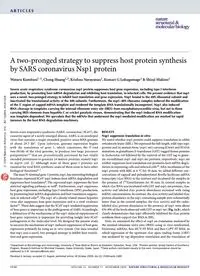
2009 A two-pronged strategy to suppress host protein synthesis by SARS coronavirus Nsp1 protein PDF
Preview 2009 A two-pronged strategy to suppress host protein synthesis by SARS coronavirus Nsp1 protein
1134 VOLUME 16 NUMBER 11 NOVEMBER 2009 nature structural & molecular biology a rt i c l e s Severe acute respiratory syndrome (SARS) coronavirus (SCoV), the causative agent of a newly emerged disease, SARS, is an enveloped virus that contains a single-stranded, positive-sense RNA genome of about 29.7 kb1. Upon infection, genome expression begins with the translation of gene 1, which constitutes the 5′-end two-thirds of the viral genome, to produce two large precursor polyproteins2,3 that are proteolytically processed by two virally encoded proteinases to generate 16 mature proteins, namely nsp1 to nsp16 (ref. 2). Although most of these gene-1 proteins are essential for viral RNA synthesis, some of them seem to have other biological functions4–7. The most N-terminal gene-1 protein, nsp1, has interesting biological functions; expressed SCoV nsp1 induces host mRNA degradation and suppresses host translation8. The expressed nsp1 suppresses the host antiviral signaling pathways as well9. Furthermore, nsp1 suppresses host gene expression, including type I interferon (IFN) production, by promoting host mRNA degradation and host translation suppres- sion in infected cells10. The nsp1 of a closely related mouse hepatitis virus also suppresses host gene expression and is a viral virulence factor11. These data suggest that the SCoV nsp1-mediated suppression of host genes is important in the pathogenesis of SARS. Accordingly, a delineation of the mechanisms of the nsp1-induced suppression of host gene expression is important for providing insight into SCoV pathogenesis at the molecular level. We designed the present study to uncover the mechanism of nsp1-induced suppression of host gene expression primarily by using an in vitro system. Our data revealed that nsp1 uses a novel, two-pronged strategy to inhibit host transla- tion and gene expression. RESULTS Nsp1 suppresses translation in vitro We tested whether nsp1 protein could suppress translation in rabbit reticulocyte lysate (RRL). We expressed the full-length, wild-type nsp1 protein and its mutant form (nsp1-mt) carrying K164A and H165A mutations as glutathione S-transferase (GST)-tagged fusion proteins in Escherichia coli followed by the removal of the GST tag to gener- ate recombinant nsp1 and nsp1-mt proteins, respectively; nsp1-mt neither suppresses host translation nor promotes host mRNA degra- dation in expressing cells and infected cells10. After incubation of the nsp1 protein with RRL at 4 °C for 30 min, we added different con- centrations of capped and polyadenylated Renilla luciferase mRNA transcripts (rLuc RNA) to the mixture and incubated the samples in the presence of [35S]methionine for 30 min. In control samples in which rLuc RNA was incubated with GST and nsp1-mt proteins, rLuc activity and labeled rLuc protein abundance increased with rising mRNA concentrations. In contrast, the rLuc activity and labeled rLuc protein abundance in the nsp1-containing sample were substantially lower than in the control samples; the rLuc activity and the radio- labeled rLuc protein abundance in the presence of nsp1 were about 6%–8% of the levels observed with GST or nsp1-mt (Fig. 1a,b), which clearly demonstrates that nsp1 efficiently inhibited the rLuc protein synthesis from capped rLuc RNA in RRL. Next, we examined the effect of nsp1 on translation mediated by the internal ribosome entry sites (IRES) using in vitro-synthesized, bicistronic mRNAs, Ren-HCV-FF RNA and Ren-CrPV-FF RNA, in which expression of the upstream rLuc open reading frame (ORF) was mediated by cap-dependent translation and the translation of 1Department of Microbiology and Immunology, University of Texas Medical Branch at Galveston, Galveston, Texas, USA. 2Present address: Global Centers of Excellence Program, Research Institute for Microbial Diseases, Osaka University, Osaka, Japan. 3These authors contributed equally to this work. Correspondence should be addressed to S.M. (
